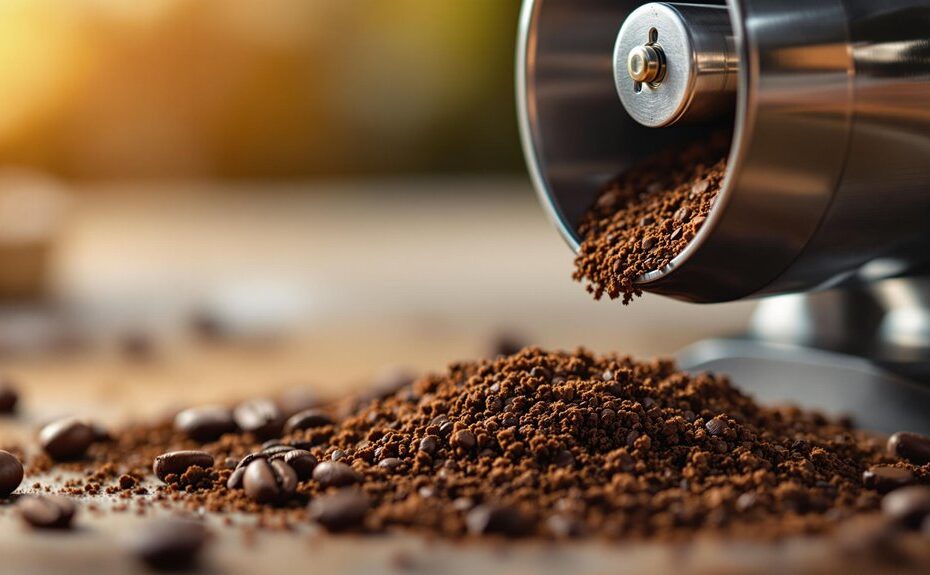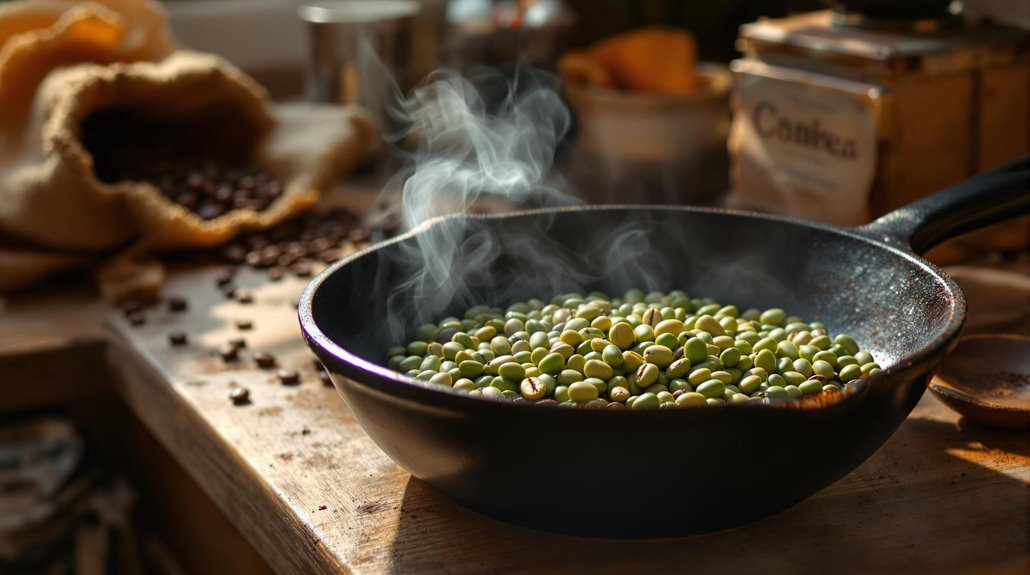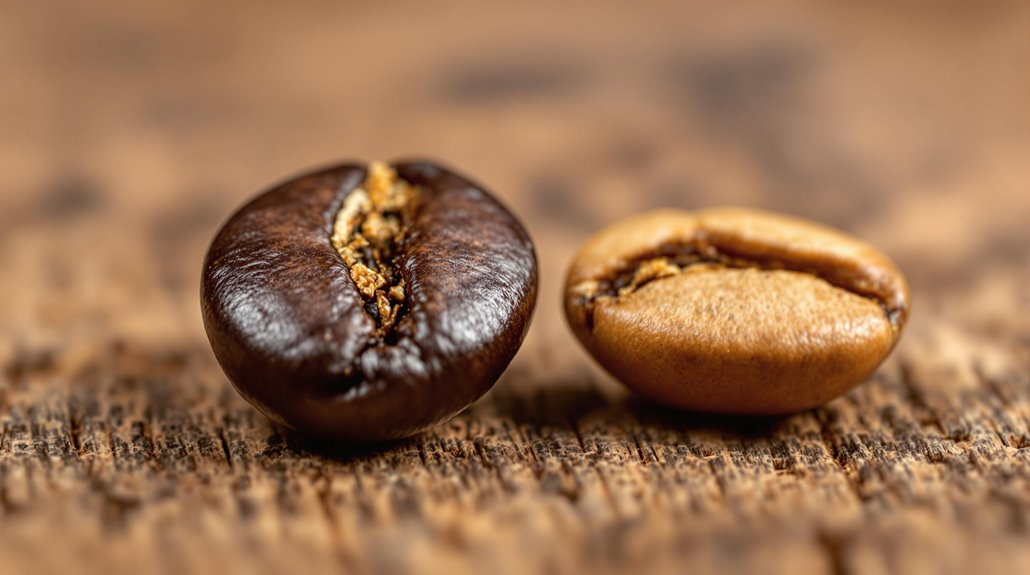







You might think grinding coffee beans is a simple task, but the difference between a mediocre cup and an exceptional one often lies in the details. The type of grinder you use, the consistency of the grind, and even the timing can drastically alter your brew. While blade grinders are convenient, they often produce uneven particles, but burr grinders promise precision—though they come with their own trade-offs. And what about manual versus electric? The answer isn't as straightforward as you'd expect. To unleash the full potential of your beans, you'll need to take into account more than just the grind itself.
Key Takeaways
- Use a burr grinder for consistent grind size, ensuring even extraction and optimal flavor balance.
- Grind beans just before brewing to preserve freshness and maximize aromatic compounds.
- Adjust grind size based on brewing method: coarse for French press, medium for drip, fine for espresso.
- Avoid overheating beans during grinding to maintain flavor and aroma integrity.
- Test and tweak grind settings to achieve the perfect size for your preferred brewing technique.
Importance of Grind Size in Coffee Brewing
Grind size plays a critical role in coffee brewing, directly influencing extraction rates and flavor balance. When you adjust your coffee grind size, you're controlling how quickly water interacts with the coffee particles. Finer grinds increase surface area, speeding up extraction, while coarser grinds slow it down. This relationship is vital because over-extraction leads to bitterness, and under-extraction results in sourness. For peak results, you must match your grind size to your brewing methods. Espresso requires a fine grind for a 30-35 second extraction, drip coffee works best with a medium grind for 4-6 minutes, and French press demands a coarse grind for 8-10 minutes.
Grind consistency is equally important. Inconsistent particle sizes cause uneven extraction, where some grounds over-extract and others under-extract, creating a muddled flavor profile. You can't rely solely on visual cues to judge grind size; taste testing and monitoring brew time are essential. A 1:16 coffee-to-water ratio is a good starting point, but you'll need to fine-tune your grind size to achieve the perfect balance. Precision in grind size guarantees you extract the full spectrum of flavors, delivering a cup that's neither bitter nor sour but perfectly balanced.
Types of Coffee Grinders and Their Features

Blade grinders use spinning blades to chop beans, but their inconsistent particle sizes make them less reliable for precise brewing. Burr grinders, on the other hand, crush beans between two plates, offering adjustable settings for uniform grind sizes, essential for ideal extraction. You'll find burrs made of stainless steel or porcelain, with stainless steel providing superior durability and heat resistance during operation.
Blade Grinders Overview
Many coffee enthusiasts start their journey with a blade grinder due to its affordability and simplicity. Blade grinders use a spinning blade to chop coffee beans into smaller particles, making them a budget-friendly option, typically priced between $20 and $50. However, the grind size and texture produced by blade grinders are often inconsistent, as the blades create a mix of fine and coarse particles. To achieve a more uniform grind, you'll need to shake or pulse the grinder during use, though this still won't match the precision of higher-end coffee grinders. Despite their limitations, blade grinders are compact and portable, making them ideal for small kitchens or travel. When grinding coffee beans with a blade grinder, keep in mind that the uneven grind can impact the flavor of your coffee, as inconsistent particles lead to uneven extraction. While blade grinders are a practical entry point for beginners, their lack of precision in grind size and texture may prompt you to explore more advanced options as your coffee expertise grows.
Burr Grinders Features
For those seeking precision and consistency in their coffee grind, burr grinders stand out as a superior choice over blade grinders. These grinders use two abrasive surfaces, or burrs, to crush beans into uniform particles, ensuring a consistent grind size. You'll find adjustable grind settings on most burr grinders, typically offering 30 to 60 levels of control, allowing you to fine-tune coarseness or fineness for brewing methods like espresso, French press, or pour-over. Conical burr grinders are quieter and generate less heat, which helps preserve the coffee's flavor profile, while flat burr grinders are faster and more durable, making them ideal for high-volume use. Electric burr grinders, such as the Baratza Encore, are perfect for home use, providing up to 40 grind settings for versatility. If portability is a priority, manual burr grinders like the Hario Skerton deliver comparable grind quality through hand-cranking, though they require more effort. Whether you choose conical or flat burr grinders, electric or manual, you'll achieve a precise grind size that enhances your coffee's flavor and extraction.
Blade Grinders: Pros and Cons

If you're looking to grind coffee beans on a budget, blade grinders stand out as an accessible option. These grinders use a spinning blade to chop the beans into smaller particles, making them a straightforward choice for beginners. However, the blade's design leads to inconsistent grind sizes, as it doesn't cut uniformly. This inconsistency can result in uneven extraction during brewing, affecting the flavor of your coffee. To mitigate this, you'll need to shake the grinder while it's running, which adds effort to the process.
Blade grinders are compact and easy to store, making them ideal for small kitchens or limited counter space. They're also affordable, often priced around $20, which makes them a practical entry point for home coffee grinding. However, their durability is limited compared to other grinders, and frequent use can cause the blade to wear out faster. While they're convenient for occasional use, their lack of precision in grinding beans may not satisfy those seeking a consistently high-quality brew. For budget-conscious coffee enthusiasts, blade grinders offer a starting point, but their limitations are worth considering.
Burr Grinders: Why They're Superior
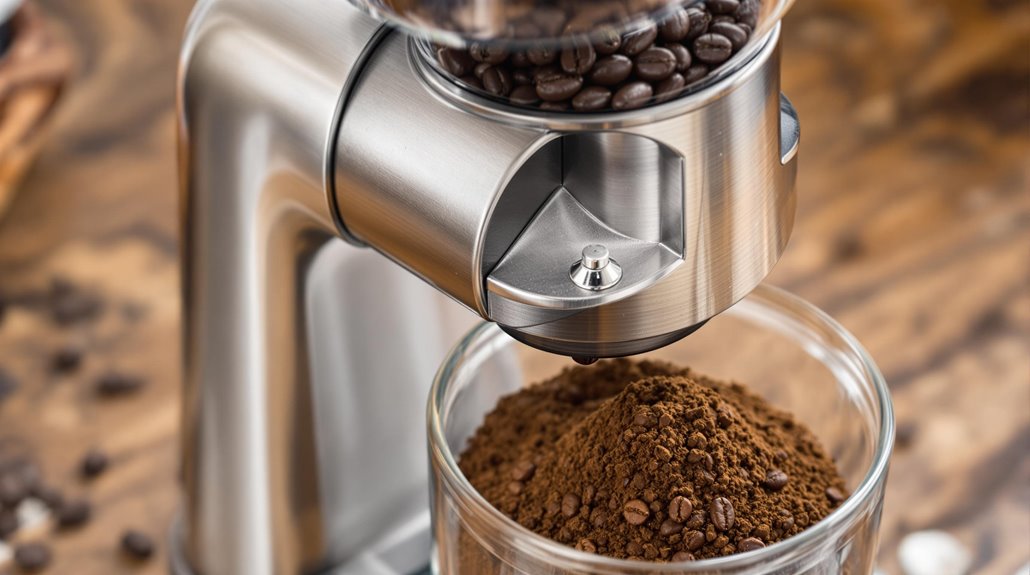
Burr grinders excel by delivering a consistent grind size, which is critical for even extraction and balanced flavor in your coffee. Their precise settings let you tailor the grind to match your brewing method, whether it's coarse for a French press or fine for espresso. This consistency, combined with reduced heat generation, guarantees your beans retain their full flavor and aromatic potential.
Consistent Grind Size
Achieving a consistent grind size is essential for releasing the full potential of your coffee, and burr grinders excel in delivering this precision. Unlike blade grinders, which produce uneven grind sizes, burr grinders use two abrasive surfaces to crush beans uniformly. This guarantees every particle is the same size, whether you're aiming for a coarse grind for French press, a medium grind for drip coffee, or a fine grind for espresso. Consistency in grind sizes directly impacts extraction, preventing over-extraction (bitterness) or under-extraction (sourness). With adjustable settings, burr grinders let you fine-tune your grind to match your brewing method, from medium-fine for pour-over to extra-coarse for cold brew. Conical burr grinders, like the Baratza Encore, offer up to 40 grind settings, giving you professional-level control at home. Additionally, burr grinders minimize heat generation during grinding, preserving the coffee's delicate flavors and aromas. By guaranteeing a consistent grind size, you'll reveal the full spectrum of your coffee's profile, making every cup a reflection of your precision and expertise.
Enhanced Flavor Extraction
Precision in coffee grinding reveals a world of enhanced flavor extraction, and burr grinders are the key to this transformation. By producing a consistent grind, burr grinders guarantee that every coffee ground is uniform, allowing water to extract flavor evenly during brewing. This consistency prevents over-extraction, which leads to bitterness, and under-extraction, which results in sourness, delivering a balanced and complex cup. With adjustable grind settings, like the Baratza Encore's 40 options, you can tailor the grind size to match specific brewing methods, from fine espresso to coarse French press. This precision maximizes flavor extraction, revealing the full potential of your beans. Unlike blade grinders, burr grinders minimize fines and boulders, reducing unwanted particles that muddy the flavor profile. Studies show that burr grinders improve flavor clarity by up to 30%, securing a cleaner, more aromatic brew. Whether you're using a pour-over, drip, or immersion method, a consistent grind from a burr grinder guarantees that every sip is rich, nuanced, and true to the coffee's origin. For peak flavor extraction, burr grinders are unmatched.
Manual vs. Electric Grinders Compared
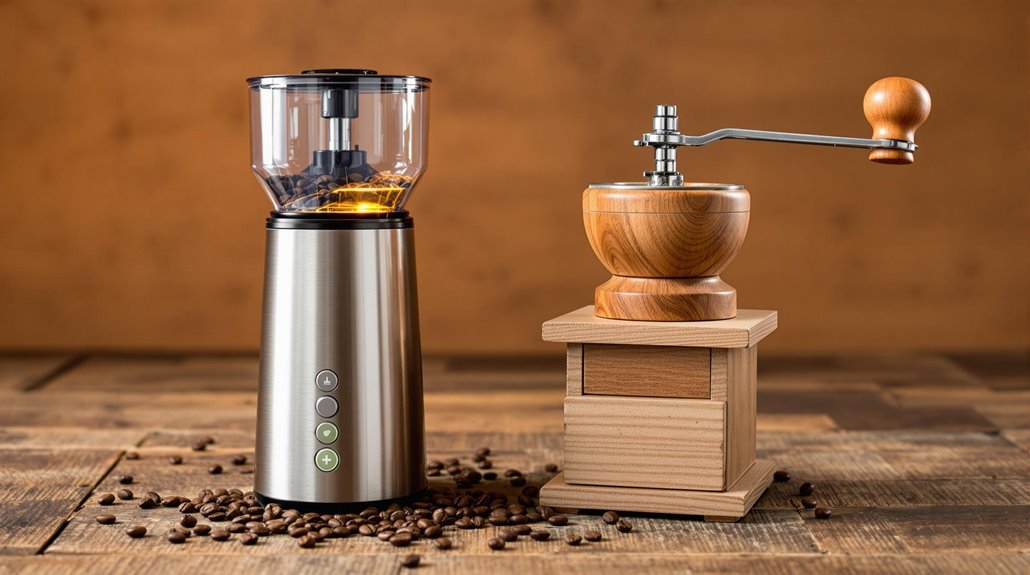
When choosing between manual and electric coffee grinders, you'll find two distinct approaches to achieving your ideal grind. Manual grinders, like the Hario Skerton, offer portability and precise control over grind size, making them ideal for travel or small batches. However, they require more effort and time, typically taking 2-3 minutes to grind 20 grams of coffee. Electric grinders, such as the Baratza Encore, provide convenience and speed, grinding the same amount in 10-15 seconds. They're better suited for daily use and larger quantities but are bulkier and more expensive, starting around $140.
Electric grinders often feature adjustable grind settings, like the Baratza Encore's 40 options, ensuring consistent particle size. Manual grinders may produce slightly less uniform grinds, though they're quieter and more affordable, ranging from $30-$80. If you prioritize consistency and efficiency, electric grinders are the superior choice. For those valuing portability and budget-friendliness, manual grinders excel. Your decision hinges on whether you favor convenience and precision or portability and cost-effectiveness.
How to Choose the Right Grind Size
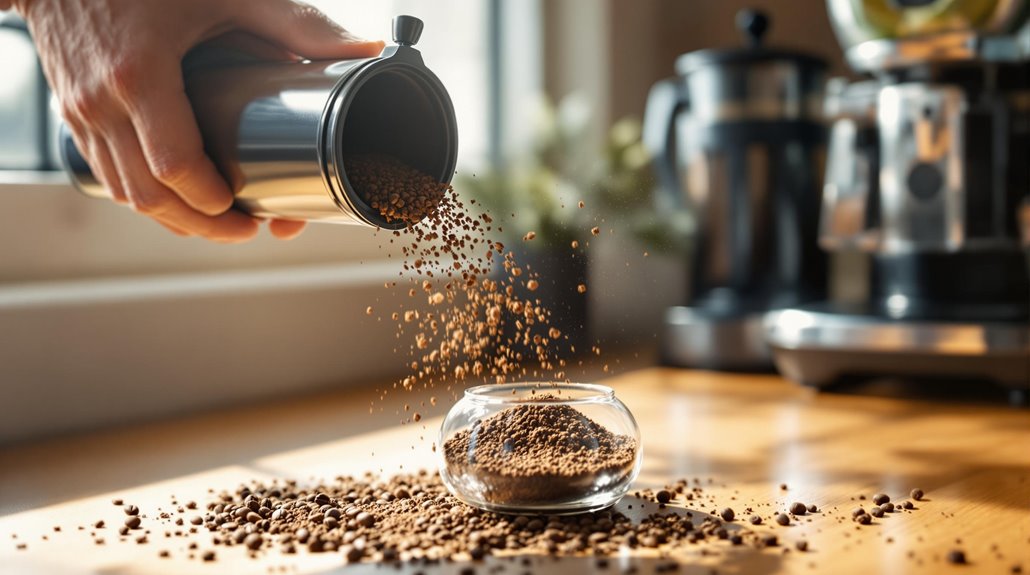
The grind size of your coffee beans directly impacts the flavor and quality of your brew, making it a key factor in your coffee-making process. To achieve the best results, you must match the grind size to your brewing method. For a coarse grind, aim for a texture resembling beach sand, which is ideal for French press or cold brew due to their longer extraction times. A medium grind, similar to fine beach sand, works well with automatic drip brewers and pour-over methods, balancing extraction and flow rate. If you're using an espresso machine, a fine grind is essential to create the pressure needed for a rich crema. For Turkish coffee, an extra fine grind guarantees a thick, intense brew. Consistency in grind size is critical—uneven particles can lead to over- or under-extraction, ruining your cup. Always adjust your grinder settings carefully, testing and tweaking until you achieve the perfect size for your preferred brewing method. Precision in grind size secures peak flavor extraction, elevating your coffee experience.
Brewing Methods and Their Grind Requirements
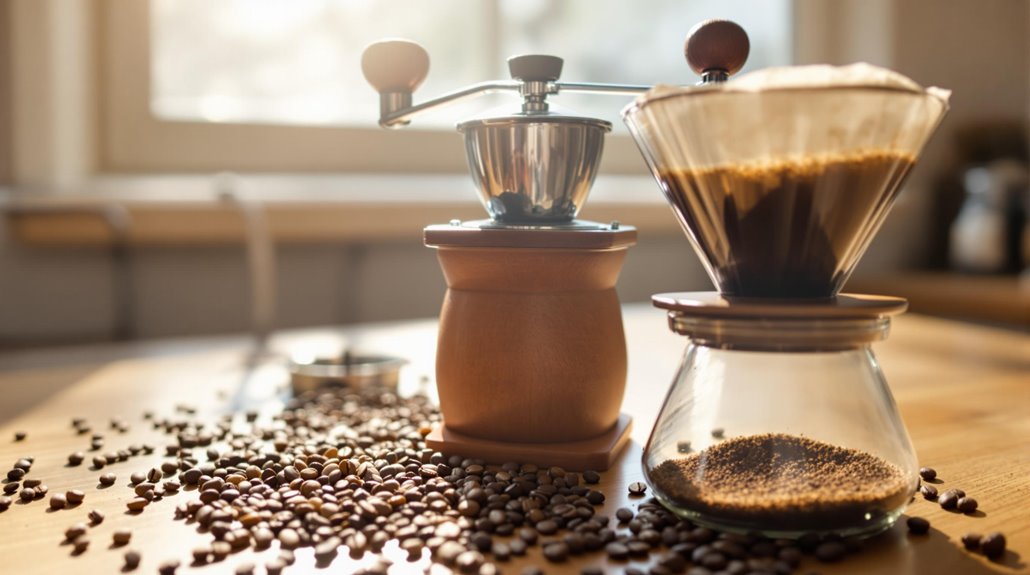
A French press's mesh filter demands a coarse grind, guaranteeing that only the liquid passes through while keeping sediment at bay. This grind size allows for full immersion brewing without clogging the filter, resulting in a robust and full-bodied cup. For espresso machines, you'll need a fine grind to create the high pressure required for extraction. The fine particles compact tightly, producing a rich crema and concentrated flavor. Pour-over methods, like Chemex or Hario V60, thrive with a medium-coarse to medium grind. This size balances extraction time and flow rate, delivering clarity and nuanced flavors. Cold brew benefits from a coarse grind to prevent over-extraction during its 12-24 hour steeping process. The larger particles secure a smooth, low-acidity brew without bitterness. Turkish coffee, on the other hand, requires an extra fine grind, almost powdery, to achieve its signature thick and rich texture. The fine particles remain suspended in the water, creating a dense and intense brew. Matching your grind size to your brewing method is essential for releasing the full potential of your coffee beans.
Grinding Coffee Without a Grinder
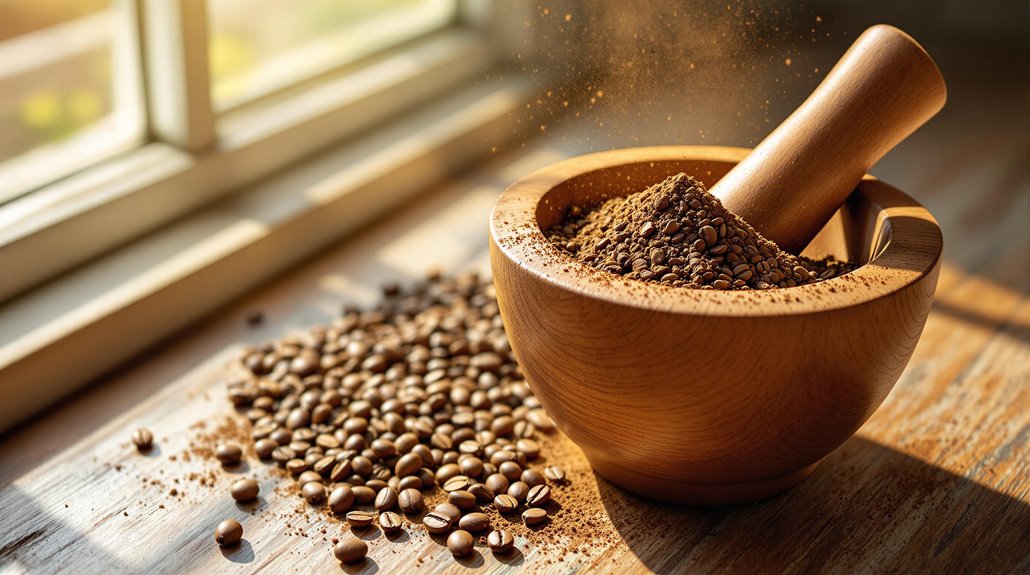
If you don't have a grinder, you can use a mortar and pestle to crush beans in small batches, applying a circular motion for even consistency. For a coarse grind, pulse beans in a blender in short bursts to prevent overheating and maintain control over texture. Alternatively, a rolling pin or meat tenderizer can crush beans for a fine grind, though results may vary in uniformity.
Mortar and Pestle Method
Using a mortar and pestle to grind coffee beans offers a hands-on approach, allowing you to control the grind size and consistency with precision. Start by placing a small batch of beans into the mortar, ensuring you don't overload it for even grinding. Use a circular, twisting motion with the pestle to break down the beans, adjusting pressure to achieve your desired grind size. For a coarse grind, ideal for French press, apply lighter pressure and grind in short intervals. For a fine grind, suitable for Turkish coffee, press firmly and grind longer, but avoid overheating the beans by working in bursts. The mortar and pestle method lets you tailor the grind consistency to your brewing method, ensuring ideal extraction. After grinding, clean the mortar and pestle thoroughly to prevent flavor cross-contamination. This technique requires patience but rewards you with full control over the grind, enhancing your coffee's flavor profile. By mastering this method, you'll achieve a grind that perfectly matches your brewing preferences.
Rolling Pin Technique
Patience and precision are key when grinding coffee beans with a rolling pin, a method that transforms whole beans into a coarse grind without specialized equipment. Start by placing your coffee beans in a sealed plastic bag or between sheets of parchment paper to contain the mess. Use a rolling pin to apply firm, even pressure, rolling back and forth over the beans. Focus on achieving a consistent coarse grind, ideal for brewing methods like French press or cold brew, which require larger particles for ideal extraction. Roll over the beans multiple times, checking the grind size frequently to avoid over-crushing. Uneven or too-fine particles can lead to over-extraction or a muddy texture in your brew. This technique works best for small batches, as it requires manual effort and attention to detail. By maintaining control over the rolling pin's pressure and motion, you'll achieve a uniform grind size that enhances the flavor profile of your coffee. While not as efficient as a grinder, this method is a practical alternative when specialized equipment isn't available.
Blender as Alternative
With a high-speed blender at your disposal, grinding coffee beans without a grinder becomes a viable option, offering a quicker alternative to manual methods. To use a blender effectively, start with whole coffee beans and pulse in short bursts to achieve a coarse to medium grind. This method works best with a high-speed blender or one equipped with a grinder setting, as it provides better control over grind size and prevents overheating the beans. Tilt the blender gently during the process to guarantee even distribution and avoid leaving larger chunks of whole beans unground. Grind small batches at a time to maintain consistency and prevent overloading the motor, which can lead to uneven ground coffee. After grinding, clean the blender thoroughly to remove coffee oils and residue, making sure it doesn't affect future blends. While a blender can't match the precision of a dedicated coffee grinder, it's a practical solution when you need to grind coffee beans without specialized equipment.
Best Practices for Grinding Coffee Beans
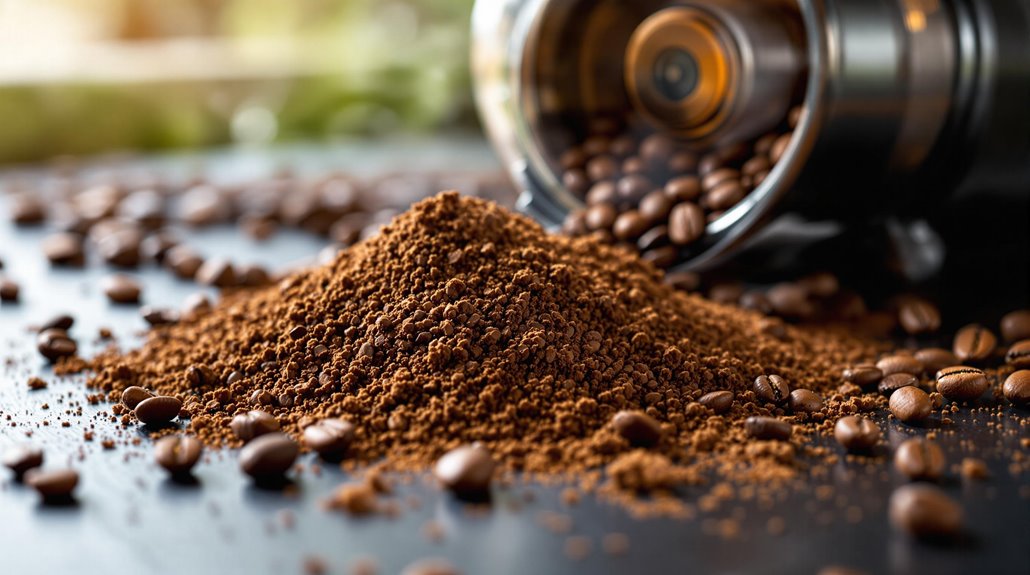
For the best results when grinding coffee beans, start by choosing a burr grinder, as it delivers a consistent grind size essential for even extraction and ideal flavor. Make sure you grind your beans just before brewing to maintain freshness, preserve aroma, and maximize taste. Adjust your grind size based on your brewing method: coarse for French press, medium for drip coffee, and fine for espresso. A consistent grind prevents uneven extraction, which can lead to bitterness or weak flavor. Avoid over-grinding to reduce friction and heat, which can cause bitterness and degrade the coffee's quality. Clean your burr grinder regularly to remove old coffee oils and residue that may affect the taste. By adhering to these practices, you can achieve peak flavor and avoid common pitfalls. Proper grinding enhances your brewing method and guarantees each cup meets your expectations. Focus on precision to extract the best characteristics from your beans.
Storing Coffee Beans for Optimal Freshness
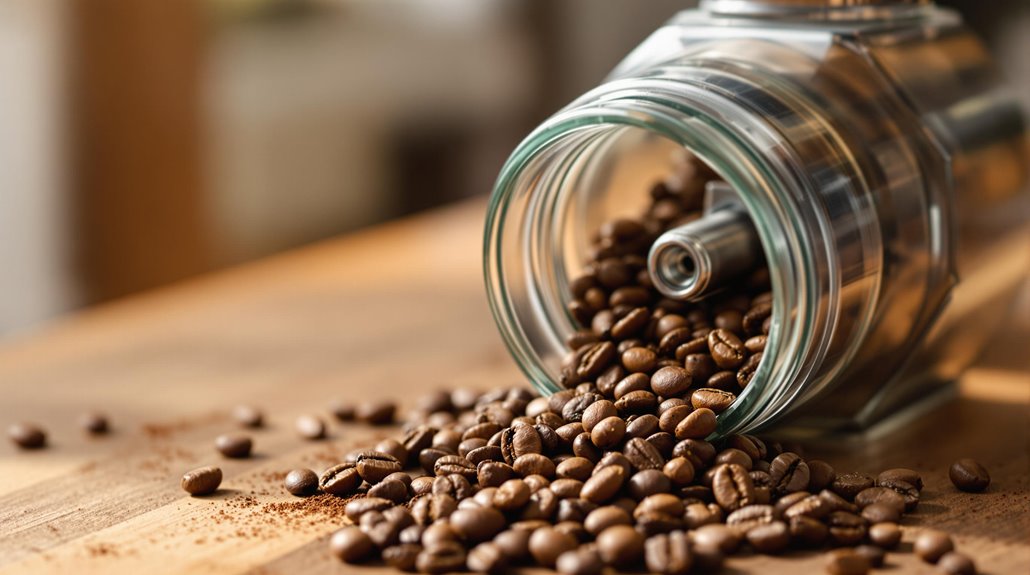
Properly storing coffee beans is just as important as grinding them correctly to secure the best flavor in your cup. To preserve freshness, always store coffee in an airtight container that shields whole beans from light, heat, and moisture. These elements accelerate oxidation, which degrades flavor and aroma. If your original coffee bag has a one-way valve, it's a suitable short-term storage option. For longer-term freshness, transfer the beans to a sealed mason jar, making certain it's kept in a cool, dark place like a pantry. Avoid freezing coffee beans, as condensation from temperature fluctuations can introduce moisture, compromising quality. Whole beans retain peak freshness for 2-3 weeks post-roasting when stored properly. Grind them immediately before brewing to maximize aromatic compounds and flavor. By prioritizing proper storage, you'll make sure your coffee maintains its complexity and richness, delivering a consistently exceptional cup.
Disclosure: As an Amazon Associate, I earn from qualifying purchases.
